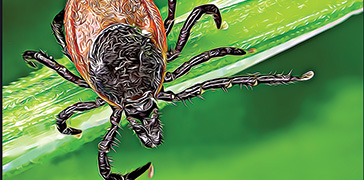US Pharm. 2024;49(4):15-16.

Spread by Infected Tick
Lyme disease was first described in 1975 in Lyme, Connecticut. Caused by the bacterium Borrelia burgdorferi, Lyme disease is transmitted to humans through the bite of an infected blacklegged tick or deer tick. The tick has to be attached for at least 24 hours for the bacterium to be transmitted. Approximately 35,000 cases of Lyme disease are reported each year, but the CDC estimates that approximately 300,000 people get Lyme disease annually. It is most prevalent in the Northeast, mid-Atlantic, and upper Midwest of the United States, but Lyme disease can also be found in neighboring states, northern California, Oregon, and Washington.
Untreated Symptoms Can Worsen
Symptoms of Lyme disease can appear from a few days to a few weeks after a tick bite. Early symptoms include rash, swollen lymph nodes, fever, chills, headache, joint pain, and muscle aches. A majority of people develop a rash, or erythema migrans, that may look like a bull’s-eye rash. It appears as a red ring and can gradually expand to 12 or more inches in diameter. It may also have a clear circle near the center. If left untreated, the symptoms can become more severe, affecting the joints, heart, and nerves over weeks, months, and even years.
The doctor will consider the reported signs and symptoms, the likelihood that someone was exposed to infected blacklegged ticks, and the possibility of other illnesses causing similar symptoms. A laboratory test may be needed. If a laboratory test is necessary, the CDC recommends a two-step testing process. If the first test is negative, then no further testing is needed. If the first test is positive, a second, confirmatory test is needed.
Curable if Diagnosed Properly
Early diagnosis and appropriate antibiotics in the early stages of Lyme disease are important to prevent late Lyme disease. Lyme disease is generally treated with oral antibiotics. The recommended antibiotics are doxycycline, amoxicillin, and cefuroxime axetil. Doxycycline is avoided in pregnant and nursing women. Alternative antibiotics include azithromycin, clarithromycin, or erythromycin for those who cannot take the recommended agents. More serious Lyme disease, involving meningitis, heart inflammation, or disease affecting the nervous system, is treated with IV antibiotics. The duration of treatment depends on the antibiotics used and the patient’s symptoms. It is critical that the patient finishes the antibiotic course, even if he or she is feeling better. Nonsteroidal anti-inflammatory drugs such as ibuprofen can help relieve muscle and joint stiffness and pain.
In most cases, patients with Lyme disease quickly experience complete recovery after antibiotic therapy. Some patients will continue to have symptoms even after treatment, known as posttreatment Lyme disease syndrome. Further treatment with antibiotics is not effective in these patients, and symptoms should improve with time.
Prevention Is the Best Defense
Ticks are most active during the summer months, but they can also be active in the late spring, early fall, or late winter. Immature ticks can be found in shady, moist ground debris, and adults can be found clinging to tall grass, brush, and shrubs. They can be in lawns and gardens, especially at the edges of woodlands and around old stone walls where deer and white-footed mice thrive. The best way to prevent Lyme disease is to avoid contact with soil, fallen leaves, and vegetation as much as possible. Preventive methods include applying a strong tick repellent to exposed skin and 0.5% permethrin to gear and clothing; wearing light-colored clothing, a hat, enclosed shoes, and long sleeves and pants; and tucking the shirt into the pants and pant legs into the socks to limit exposed skin.
Check thoroughly for ticks after spending time outdoors. Ticks can hide on the scalp, in the armpits, behind the knees, in groin hair, and on other parts of the body that are difficult to see. Shower as soon as possible, and wash and dry clothes on high heat for 10 minutes. If it is attached to the skin, remove the entire tick with fine-tipped tweezers, grasping the tick as close to the skin surface as possible and pulling straight up. Clean the bite area thoroughly. Dispose of the tick by placing it in alcohol or a sealed container, wrapping it tightly in tape, or flushing it down the toilet. Removing a tick within 24 hours can decrease the chance of getting Lyme disease.
The content contained in this article is for informational purposes only. The content is not intended to be a substitute for professional advice. Reliance on any information provided in this article is solely at your own risk.
To comment on this article, contact rdavidson@uspharmacist.com.





